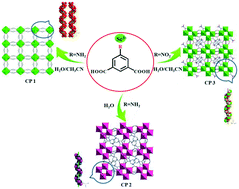Three helical chain-based 3D coordination polymers: solvent-induced syntheses, tunable structures and catalytic properties for the Strecker reaction†
Abstract
Three three-dimensional (3D) helical chain-based coordination polymers [Sc(aip)(OH)·(H2O)]n (1), [Sc2(aip)3]n (2) and [Sc2(nip)3]n (3) (H2aip = 5-aminoisophthalic acid, H2nip = 5-nitroisophthalic acid) have been synthesized through solvent induction without any chiral auxiliary systematically. We first synthesized CP 1, a 3D network, which contains intertwined left- and right-hand helical chains {–ScO6–OH–}n. By changing the polarity of the solvents from CH3CN/H2O to H2O, a genuine single helix of 2 was constructed, in which adjacent Sc(COO)6 polyhedra are connected alternately by aip2− ligands to form a 3D framework with intertwined parallel left-hand helical chains {–Sc1(COO)–Sc2(COO)–}n. Then by changing the substituent of the ligand, CP 3 was obtained with right-handed helical chains. As for 3, the aip2− ligands bridge Sc(III) ions alternately into infinite right-handed helical chains {–Sc(COO)–}n, which serve as secondary building units (SBU) to generate a 3D framework. Solid-state circular dichroism spectrum confirms that 3 is optically active. We also studied the catalytic properties of 1–3 in the Strecker reaction. Importantly, 1 shows excellent catalytic activity under mild conditions and can be reused at least four times without significant reduction in catalytic ability.



 Please wait while we load your content...
Please wait while we load your content...